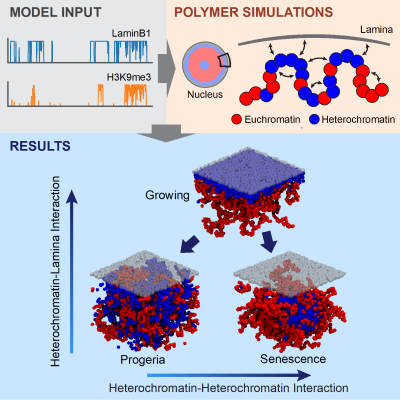Physicists and biologists work together to shed light on genome reorganisation in senescence
Scientists from the School of Physics and Astronomy and the MRC Human Genetics Unit at the University of Edinburgh work together to uncover mechanisms governing genome reorganisation in senescence: September 2019

In aged or malfunctioning cells, cellular senescence is a common response to prevent stresses, such as DNA damages or the activation of cancer-causing genes, from inflicting further harm to an organism. Previous research has shown that senescent cells undergo substantial changes in genome organisation from healthy, growing cells. However, the mechanisms underlying this change in organisation and how it connects to the functional role of senescence remain unclear.
A team of co-workers assembled by Prof Davide Marenduzzo, from the School of Physics and Astronomy, and Dr Tamir Chandra, from the MRC Human Genetics Unit, tackled this problem using an interdisciplinary approach. The group integrated polymer modelling, microscopy, and mass spectrometry to dissect the roles played by two key features in the nucleus – heterochromatin and lamina – on genome reorganisation in senescence.
An important finding of their work is that the reorganisation in senescence can be understood as phase transitions between different physical states. Phase transitions are ubiquitous in everyday life. A classic example is the solid-liquid transition of water. By changing temperature, for example, water molecules can alter their arrangement and move between the solid and the liquid state with different physical properties. Similarly, by changing the strength of heterochromatin- and lamina- mediated interactions, the genome adopts organisations that are associated with different biological conditions, such as being healthy or senescent.
To me, it is fascinating to see how a simple physics-based polymer model that depends on only two parameters can qualitatively capture the nuclear reorganisation in senescent cells.
In addition, their work explains the change in the network of genomic contacts in senescence that has been observed in previous experiments. More importantly, their work predicts a physical reason that could explain why it is difficult for senescent cells to revert to their normal condition. In the future, they intend to refine their computer model to gain further insight into the genome rearrangement process at the onset of senescence.
Links
Original article: https://doi.org/10.1016/j.celrep.2019.08.045
Chandra Research Group


